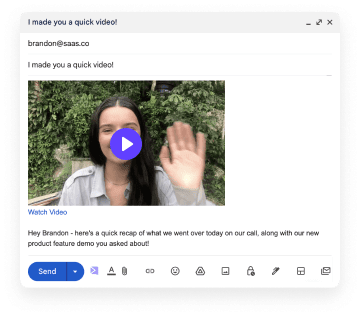Email prospecting is one of the most powerful tools for B2B sales teams—but it’s also one of the most misunderstood. Flooded inboxes, busy decision-makers, and spam filters make it easy for even well-written outreach emails to get ignored.
That’s why understanding email prospecting best practices makes the difference between a delete and a reply.
In this guide, we’ll walk through proven strategies everyday reps can use to improve open rates, increase reply rates, and build real conversations through email outreach. We’ll share real-world examples, concrete dos and don’ts, and actionable tips to become more effective with every send. Let’s get into it.
Table of Contents
- What Is Email Prospecting?
- Before You Write: Nail Your Email Infrastructure
- Crafting the Perfect Subject Line
- Writing Personalized, Short Emails That Get Replies
- Using Video to Stand Out in the Inbox
- Timing, Cadence, and Follow-ups
- Common Mistakes to Avoid
- Final Thoughts + Next Steps
What Is Email Prospecting?
Email prospecting is the practice of reaching out to potential customers via email who haven’t yet expressed interest. It’s cold contact—but when done right, it doesn’t feel cold. The goal isn’t just to sell—it’s to start a conversation, qualify interest, and build momentum toward a call, demo, or sale.
For B2B SaaS companies, email prospecting often begins with lead lists built from tools like LinkedIn Sales Navigator, which we covered in this deep-dive guide. Once you have the right targets, your job is to earn their attention with words, video, or visuals that actually feel worth their time.
Before You Write: Nail Your Email Infrastructure
Before you send a single prospecting email, you need to make sure it will actually land in the inbox. The best messaging in the world won’t matter if your domain is flagged, your IP is cold, or your setup screams “spam.”
This is where many teams fail—not with copy, but with infrastructure.
Why Email Deliverability Comes First
Even small technical missteps can torpedo your outreach. Think:
- Your domain isn’t authenticated with SPF, DKIM, and DMARC
- You're sending from a brand-new domain or IP with no warm-up history
- Your sending volume suddenly spikes, triggering spam filters
These red flags make it harder to even reach your target, let alone convert them.
Tools to Set You Up for Success
To maximize deliverability, use these tools and best practices before launching your first campaign:
- Mailreach – Automate inbox warm-up and maintain a healthy sender reputation
- Folderly – Diagnose spam issues and continuously monitor deliverability
- Lemwarm – Built-in warm-up tool inside Lemlist
- MXToolbox – Run free diagnostics on your domain and check blacklist status
- GlockApps – Test where your emails are landing (inbox, promotions, spam)
Best Practices to Follow
- Set up dedicated sending domains (e.g., outreach.yourcompany.com)
- Warm up your domain gradually—start with low volume and scale over 3–4 weeks
- Keep your bounce rate below 2% and aim for 80%+ inbox placement
- Use email validation tools like NeverBounce or ZeroBounce to clean your list before sending
TL;DR: Your messaging doesn’t matter if your emails don’t get delivered. Before you optimize for opens and replies, optimize for inbox placement. Get your infrastructure right, then scale outreach with confidence.

Crafting the Perfect Subject Line
Subject lines can make or break your entire outreach effort. In fact, HubSpot reports that 47% of email recipients decide whether to open an email based on the subject line alone.
Keep It Short and Human
A subject line like “Quick question about marketing at Acme Corp” feels natural and tailored. Avoid gimmicks like “🔥 You won’t BELIEVE this offer!” or clickbait that your audience sees coming a mile away.
Use First Names or Company Names
Adding personalization—even just their name—can increase open rates by 22%. Tools like Sendspark let you automate personalization using tokens that pull in data like name, company, or title right into video thumbnails or subject lines.
Test, Don’t Guess
Use A/B testing with small sample groups to identify what works. Try one subject line that’s casual, one that’s curiosity-based, and one that’s straightforward to see what sticks.
See 21 proven subject lines that actually get opened →
Writing Personalized, Short Emails That Get Replies
Your prospects don’t have time to read novels. The most effective prospecting emails are often fewer than 125 words but still manage to feel thoughtful—because they’re personal and relevant.
A Formula That Works
Use this 3-line structure:
- Personalized opener – “Saw your recent announcement about expanding your remote team—congrats!”
- Value prop – “I help SaaS companies like Brikl improve async onboarding with video.”
- Call to action – “Would you be open to seeing a quick example tomorrow?”
Personalized emails increase reply rates by 142% (source: Gong). Just taking 60 seconds to reference something specific can make your message feel 1:1.
Tools to Scale Personalization
You don’t need to write every email manually. Tools like Sendspark’s workflows and AI-powered scripts help you personalize videos and email copy at scale—without losing that human touch.
Using Video to Stand Out in the Inbox
It’s no longer enough to just write better copy.
The fastest-growing teams are using video inside prospecting emails to boost engagement and build trust—faster.
Real Results from Real Teams
Hipersa, a tech-enabled sourcing platform, increased email reply rates by 73% within six weeks using personalized videos from Sendspark.
How to Add Video to Your Emails
With Sendspark, you can:
- Record or generate personalized videos with AI
- Add their name, company, or job title to the video thumbnail
- Embed videos directly into email tools like Gmail, HubSpot, or Outreach
.png?width=829&height=360&name=_-%20visual%20selection%20(1).png)
Timing, Cadence, and Follow-ups
Even a perfect first message won’t land every time. That’s why timing and consistent follow-ups matter.
Timing Isn’t Random
Tuesdays and Thursdays between 8–10 AM typically yield the best engagement (OptiMonk data). Avoid Monday morning and Friday afternoon sends.
A Proven Follow-Up Cadence
- Day 1 – Value-focused intro email
- Day 3 – Follow-up with a personalized video
- Day 6 – Resource or mini-case study
- Day 10 – Respectful “breakup” email
Don’t just write “bumping this”—bring value with each message. A new insight, a relevant testimonial, or even a pattern interrupt video can reignite interest.
Automation That Feels Human
Sendspark lets you create automated video sequences that feel 1:1. Your follow-ups can feel custom—without requiring manual sends every time.
Common Mistakes to Avoid
Even seasoned reps fall into these traps:
Over-Automation
Mass emails with no context = instant delete. Personalization tokens can’t save a message that reads like spam.
Misleading Subject–Body Alignment
If your subject says “Quick idea for Q3” and your email is a hard pitch, you’ll lose trust. Match your tone from subject to CTA.
Too Many Links
Stick to one CTA. More than one link can trigger spam filters and distract from the main message. Let your video do the storytelling.
Read how video affects email deliverability →
Final Thoughts + Next Steps
Mastering email prospecting isn’t about volume—it’s about value. Every message is a chance to show your prospect you’ve done your homework, that you respect their time, and that you can actually help.
✅ Set up your infrastructure
✅ Personalize your message
✅ Use video to stand out
✅ Follow up like a pro
If you’re ready to send outreach that gets replies, try Sendspark for free and see how easy it is to scale video prospecting that feels personal.
FAQs: Email Prospecting for B2B Sales
- How long should a cold email be?
Keep it under 125 words. Short emails that feel personalized and relevant are far more likely to be read and replied to. - What’s the best day and time to send prospecting emails?
Tuesday and Thursday mornings (8–10 AM local time) consistently perform best, but testing different times with your audience is essential. - How many follow-ups should I send?
Three to four follow-ups spaced over 10–14 days is a good benchmark. Each should offer new value—never just a “bump.” - Should I include a video in my first email?
Yes—adding a personalized video in your first or second touch can boost reply rates by 3–5x. Even a simple thumbnail with the recipient’s name drives clicks. - What tools can help me personalize cold emails at scale?
Sendspark helps you create and send personalized video emails at scale. Pair it with outreach platforms like HubSpot, Outreach, or Apollo for maximum efficiency. - How do I improve email deliverability?
Authenticate your domain (SPF, DKIM, DMARC), warm up your sender domain gradually, and validate emails with tools like NeverBounce or ZeroBounce. - What subject lines work best for cold email?
Keep them short, personalized, and curiosity-driven. Avoid clickbait. Subject lines that reference the recipient’s company or role typically get the highest opens. - Should I use HTML or plain text in cold emails?
Plain text usually performs better for cold outreach. It feels more human and is less likely to get flagged by spam filters. - How do I measure success in email prospecting?
Track open rate (20–40%), reply rate (5–15%), and booked meetings. Video emails often show higher engagement and conversion rates.




